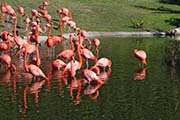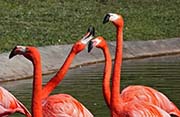Juvenile

Note the short legs on this young juvenile
07/08/2012 - San Diego Zoo, CA
Note the short legs on this young juvenile
07/08/2012 - San Diego Zoo, CA
|

07/08/2012 - San Diego Zoo, CA
07/08/2012 - San Diego Zoo, CA
|

07/08/2012 - San Diego Zoo, CA
07/08/2012 - San Diego Zoo, CA
|

Juvenile
01/27/2012 - Audubon Zoo, New Orleans, LA
Juvenile
01/27/2012 - Audubon Zoo, New Orleans, LA
|
|
|
Adult

03/25/2012 - San Diego Zoo, CA
03/25/2012 - San Diego Zoo, CA
|

03/25/2012 - San Diego Zoo, CA
03/25/2012 - San Diego Zoo, CA
|

12/14/2010 - Jungle Island, Miami, FL
12/14/2010 - Jungle Island, Miami, FL
|

White Ibis in background
12/14/2010 - Jungle Island, Miami, FL
White Ibis in background
12/14/2010 - Jungle Island, Miami, FL
|

12/14/2010 - Jungle Island, Miami, FL
12/14/2010 - Jungle Island, Miami, FL
|

12/18/2010 - Flamingo Gardens & Wildlife Sanctuary, Davie, FL
12/18/2010 - Flamingo Gardens & Wildlife Sanctuary, Davie, FL
|
Diet:
Flamingos have very long legs and they are able to search
for food in deep water.
Flamingos eat by using their feet to stir up mud and then sucking
in this mud and water through their bill and out the sides.
Briny plates in their mouth filter out
brine flies, shrimps and mollusks.
The carotenoid pigments found in the crustaceans they eat
gives them the bright pink plumage.
Courtship:
Flamingos perform elaborate group displays before, during and after breeding.
Sometimes they perform one display together, other times they
will perform a sequence of displays.
Display include stretching their neck and pointing they bill
upward and swaying they head back and forth.
Another includes a group of flamingos marching together in synchronized steps.
The displays are accompanied by loud growling and grunting sounds.
Nesting:
Like the Greater Flamingo, both parents build the mud nest by using
their bills to move the mud to a height of about 12".
The height is needed to keep the single egg laid dry and not too hot.
Both parents incubate the egg and when it hatches, they both
feed the chick crop milk
that is produced by a gland in the parents' upper digestive tract.
This bright red liquid is nutritionally similar to mammalian milk.
Habitat and Range:
American Flamingos
live in the shallow water ways of the Galapagos Islands,
Southern Caribbean, Yucatan Peninsula, and Northern Caribbean.
Vocalization:
They produce loud growling and grunting sounds during the breeding season.
Plumage/Molt:
No alternate plumage.
Migration:
Flamingos don't normally migrate, but will if their habitat degrades.
For example, if their lake freezes or there is a drought.
When they do migrate, they tend to migrate at night and fly at high altitudes.
When they fly, Flamingos need space to take off.
They need to run far enough to generate the lift need to take off.
Tongue/feet:
Pink feet and legs.
Bibliography:
- http://en.wikipedia.org The Free Encyclopedia, Accessed June 2012
- http://www.sandiegozoo.org/animalbytes/ San Diego Zoo, Accessed June 2012
- http://www.auduboninstitute.org/animals/ Audubon Nature Institue, Accessed June 2012
- http://www.zoo.org Woodland Park Zoo, Seattle, WA, Accessed June 2012
- http://violets-and-lace.com/archives/category/birds Growing to a Better Future, Accessed June 2012
Top of Page









